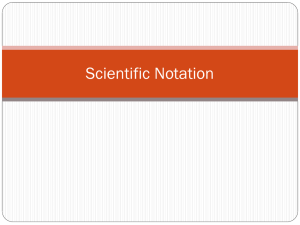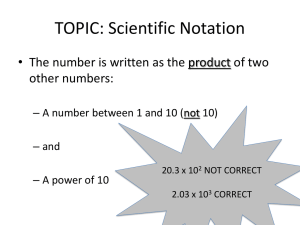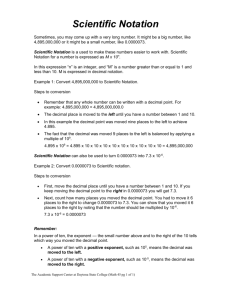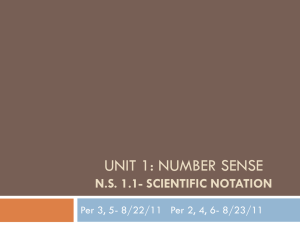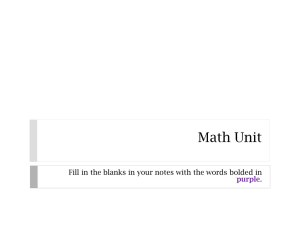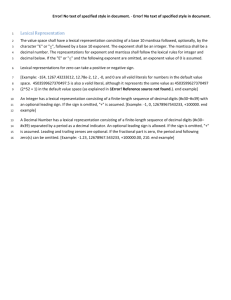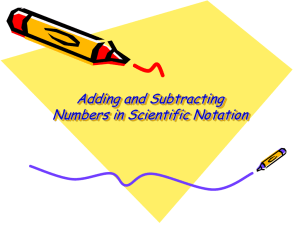Scientific notation and metric conversions – Updated
advertisement
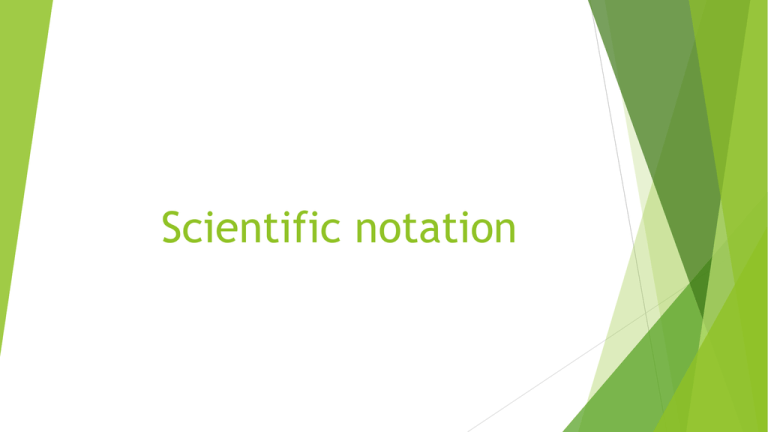
Scientific notation Shorten the text message! The following text message is too long. Find a way to shorten it using common text message abbreviation: “Hey Stacy! Are we still going to study after school tomorrow? Well, talk to you later. See you!” When we use abbreviations such as lol, ttyl, idk, 2morro, or cu, we are saving ourselves time and energy. The purpose it to convert long words or phrases into short, single strand phrases. Scientific notation is the same way. Notes: Scientific notation is a method of expressing very large or very small numbers in a concise manner. Example: You can write 1,000,000,000,000 But wouldn’t it be easier to write 1.0x1012? How to convert to S.N. 1) Move the decimal so that it is directly behind the first non-zero SINGLE digit. For example: 2,498,0000 -> 2.4980000 2) Drop all of the TRAILING zeroes. 2.4980000 -> 2.498 3) Write x10x behind the newly formed number, where x (the little one) is the number of times the decimal was moved. 2,498,0000 ->2.4980000 The decimal was moved 6 times, so we write, 2.4980000 -> 2.498 -> 2.498x106 General Rules: When we move the decimal to the left, the exponent is positive. The original number was greater than one. When we move the decimal to the right, the exponent is negative. The original number was less than one. Examples: 240,000,000 -> 2.4x108 0.000049 -> 4.9x10-5 Moving to the left 568 200 1. Move the decimal: 2. Drop the extra zeroes: 3. Find the exponent on the 10 (it is best to do this while moving the decimal): 4. Finally, write the number in Scientific Notation (abbreviated S.N.): Moving to the right 0.000002340000 1. Move the decimal: 2. Drop the extra zeroes: 3. Find the exponent on the 10 (remember, left = positive while right = negative): 4. Write the number in S.N.: Questions: Convert the following standard form numbers to S.N.: 0.000002500700 244 129 000 000 0.0000000019 4,040 248,945,478 0.250700 782,541 40 0.000008825 1 5,200 0.000505 0.000000000008 56,000 1,782,941 Significant Digits – Scientific Notation In scientific notation, all numbers prior to the x are significant. 4.0 × 103 = two sig. digs. 6.724 × 10-18 = four sig. digs. Converting back to standard form Option 1: Multiply the two terms (the decimal between 1 and 10 and the power of 10). Ex. 2.14 x 104 = 2.14 x 10000 = 21 400 *This method works because writing 2.14x104 is the same as writing 2.14 x 10 x 10 x 10 x 10* Option 2: Move the decimal to the right (if the exponent is positive) or to the left (if the exponent is negative) x times, where x is the value of the exponent (if the exponent is 4, move the decimal to the right 4 places). Add zeroes where necessary. Ex. 2.14 x 104 21400. Questions: Convert the following S.N. numbers to standard form: 2.187 x 104 7.9 x 10-9 4.9 x 10-10 3.88 x 10-7 1.001 x104 2.701 x 105 4.7 x 101 1.0 x 10-5 9.472 x 108 4.808 x 10-4 2.80 x 10 11 1.0 x 1012 7.29017 x 108 7.4051 x 10-11 1.0 x 10-12 1.0 x 10-1 2.8 x 105 4.8249 x 104 Comparing values Identify the number with the greater value in the following pairs: 2.14 x 102 and 3.14 x 102 1.0 x 104 and 1.0 x 102 7.8 x 10-5 and 9.2 x 10-5 2.2 x 10-2 and 2.2 x 10-4 Metric Unit Conversions When going from a BIG unit to a smaller unit (left to right on the chart), MULTIPLY. When going from a SMALL unit to a bigger unit (right to left), DIVIDE. Each successive movement to the right/left is a shift of one power of ten. For example, converting from cm to m involves TWO moves to the left, so we DIVIDE by 100 (10x10). Example Convert 52 000 centimetres to kilometres. Example Convert 0.00245 g into mg. Questions: Answer the following questions to the best of your ability: 1426 m into km 289 477 g into kg 0.000098 km into cm 24 685 mL into L 0.19 km into mm 0.001 g into mg 2450 mg into g 0.000051 km into mm
